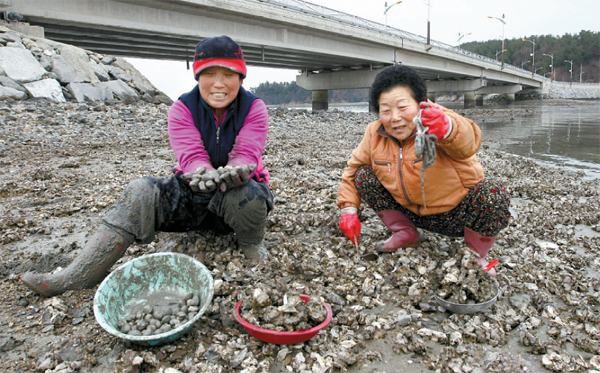County unites to save tidal flats for fishmongers

Two clam diggers from a fishing village in Jangheung County, South Jeolla, show their catch, along with a live octopus, taken from the Sachon-ri mudflat on Jan. 17, that until two years ago was almost depleted. By Oh Jong-chan
The oyster bed, once on the brink of depletion, now is rife with sea life and glistens under the winter sunlight in a fishing village on the southernmost coast of Korea.
On Jan. 17, when the JoongAng Ilbo visited a small town in Anyang-myeon, Jangheung County in South Jeolla, several spry villagers were picking oysters and clams from the 500-acre mud bed. Small crabs also crawled around in the gooey mud.
Kim Bok-soon, 74, holding up her plastic bucket filled to the brim with cockles, stated, “Catching cockles, I make side dishes and sell them to earn pocket money for my grandson. When the day is warm, mudskippers squirm around in the mudflat.”
Just three years ago, the mudflat in front of Sachon-ri village was almost dried out because of the location of a little island, Jangjae Island, in front of the village. From 1950 an embankment was built in the 656 yards between the village and the island, blocking the Boseong Bay seawater from flowing to the Sachon-ri shores. Sanchon-ri is located on the coast of a smaller bay that carves into Boseong Bay.
“Ever since the deposits formed, the mudflats that were once laden with short-neck clams and cockles when I was young have begun to smell,” said Kim.
When Jangheung County became aware of the grievances of the Sachon-ri fishmongers, they hatched a plan. In order to save the mudflat and fishery, it was vital to demolish a part of the embankment between the coast of the island and the village. The county spent 51.9 billion won ($46.2 million) between 2006 and 2009, digging up 131 yards between the two coasts and building a bridge to join them.
People and cars could go back and forth between the two banks as before, but now, under the bridge, the ocean water could flow into the bay.
And the mud banks that were once more seeped in seawater began to gradually revive the following year. Last year, the mudflats began to flourish once more, lush with various shellfish.
Chief of the fishing village, Kim Du-hong, 46, stated, “Last year cockles were discovered again and this year, the number has increased greatly,” adding that they get many calls to buy shellfish from outside the village.
Kim estimates that the villagers will collect as much as 100 tons of shellfish between February and March. Sold at 25,000 won per kilogram (2.2 pounds), the village may make an income of 250 million won, a significant sum for its 240 some residents.
Professor of biology at Gwangju University, Yang Sung-ryull, also on the trip, stated, “In the past ten years in the southern coast of Korea, there has been no place where such a large amount of cockles have been discovered besides Sachon-ri” and that there is evidence that “the mud flat has been revived.”
An official of Jangheung County’s maritime affairs and fisheries division, Jung Chang-tae, stated, “As the seawater circulated well, not only the mudflat in front of Sachon-ri village but also some 2,471 acres of mudflat in front of Anyang-myeon is being revived.”
Meanwhile, the beach area east of Sachon-ri is also showing change. Previously, due to coastal erosion, the sand washed out and 25 tons of sand were needed each year to replenish the supply, but after the embankment was dug up, and seawater allowed to flow into the bay, much less was needed.
By Kang Chan-su [sarahkim@joongang.co.kr]










with the Korea JoongAng Daily
To write comments, please log in to one of the accounts.
Standards Board Policy (0/250자)